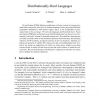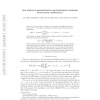156
click to vote
FOCS
1992
IEEE
15 years 4 months ago
1992
IEEE
We announce methods for e cient management of solvable matrix groups over nite elds. We show that solvability and nilpotence can be tested in polynomial-time. Such e ciency seems ...
78
Voted
COCO
1993
Springer
15 years 4 months ago
1993
Springer
Recently Lutz [14,15] introduced a polynomial time bounded version of Lebesgue measure. He and others (see e.g. [11,13,14,15,16,17,18,20]) used this concept to investigate the quan...
99
Voted
PKC
1999
Springer
15 years 4 months ago
1999
Springer
This paper introduces a method for tracking different copies of functionally equivalent algorithms containing identification marks known to the attacker. Unlike all previous solu...
96
Voted
COCOON
1999
Springer
15 years 4 months ago
1999
Springer
Cai and Selman [CS99] defined a modification of Levin’s notion of average polynomial time and proved, for every P-bi-immune language L and every polynomial-time computable dis...
FOCS
1999
IEEE
15 years 4 months ago
1999
IEEE
We show that the minimum distance of a linear code is not approximable to within any constant factor in random polynomial time (RP), unless nondeterministic polynomial time (NP) eq...
115
click to vote
COLT
2001
Springer
15 years 5 months ago
2001
Springer
We show that the class of monotone 2O( √ log n)-term DNF formulae can be PAC learned in polynomial time under the uniform distribution from random examples only. This is an expo...
108
click to vote
ISAAC
2009
Springer
15 years 5 months ago
2009
Springer
For a graph G and a collection of vertex pairs {(s1, t1), . . . , (sk, tk)}, the k disjoint paths problem is to find k vertex-disjoint paths P1, . . . , Pk, where Pi is a path fr...
94
Voted
GD
2009
Springer
15 years 5 months ago
2009
Springer
A graph G is a support for a hypergraph H = (V, S) if the vertices of G correspond to the vertices of H such that for each hyperedge Si ∈ S the subgraph of G induced by Si is co...
101
Voted
ICALP
2010
Springer
15 years 5 months ago
2010
Springer
Given a positive integer n and a positive semidefinite matrix A = (Aij ) ∈ Rm×m the positive semidefinite Grothendieck problem with rank-nconstraint is (SDPn) maximize mX i=1 ...
100
click to vote
SIGECOM
2003
ACM
15 years 5 months ago
2003
ACM
Preference elicitation — the process of asking queries to determine parties’ preferences — is a key part of many problems in electronic commerce. For example, a shopping age...



